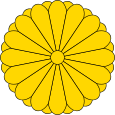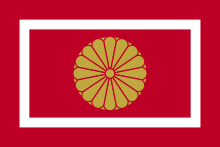- Crown Prince Naruhito
-
Naruhito
皇太子徳仁親王
Spouse Crown Princess Masako Issue Aiko, Princess Toshi Father Emperor Akihito Mother Empress Michiko Born 23 February 1960
Tōgū Palace, JapanCrown Prince Naruhito (皇太子徳仁親王 Kōtaishi Naruhito Shinnō) /naɺ̠u͍çito/ (born 23 February 1960) is the eldest son of Emperor Akihito and Empress Michiko, which makes him the heir apparent to the Chrysanthemum Throne of Japan.
Contents
Early life and education
Titled Prince Hiro (浩宮 Hiro-no-miya), he was invested as the Crown Prince on 23 February 1991,[1] following the death of his grandfather, Emperor Shōwa on 7 January 1989.
He received his bachelor's and his master's degrees in history from Gakushuin University in 1982 and 1988, respectively. From 1983 until 1985 he studied in England at Merton College, Oxford University.
Prince Naruhito plays the viola and enjoys jogging, hiking, and mountaineering in his spare time. He has written several papers and a memoir of his Oxford days, The Thames and I: A Memoir of Two Years at Oxford.
Marriage and issue
The Prince pursued and eventually proposed (reportedly twice) to the then 29-year-old Masako Owada, a diplomat in the Japanese Foreign Ministry working under her father Hisashi Owada who is currently a judge on the International Court of Justice, former vice minister for foreign affairs and former Japanese ambassador to the United Nations. The Imperial Palace announced their engagement on 19 January 1993.
On 9 June 1993, The Crown Prince of Japan and Masako Owada were married at the Imperial Shinto Hall in Tokyo before 800 invited guests and an estimated media audience of 500 million people around the world. Many of Europe's crowned heads attended. So, too, did most of Europe's elected heads of state. The couple make their home at the Tōgū Palace, on the Akasaka Estate in Minato, Tokyo.
Naruhito has one daughter from his marriage:
- Aiko, Princess Toshi, born 1 December 2001.
Imperial succession controversy
Imperial House of Japan
Aiko's birth, which occurred more than eight years after their marriage, sparked lively debate in Japan about whether The Imperial Household Law of 1947 should be changed from that of agnatic primogeniture to absolute primogeniture, which would allow a woman to ascend to the Chrysanthemum Throne.
A government-appointed panel of experts submitted a report on 25 October 2005, recommending that the Imperial succession law be amended to permit absolute primogeniture. On 20 January 2006, then Prime Minister Junichiro Koizumi used part of his annual keynote speech to address the controversy when he pledged to submit a bill to the Diet letting women ascend to the throne in order that the imperial throne be continued into the future in a stable manner. Koizumi did not announce a timing for the legislation to be introduced nor did he provide details about the content but he did note that it would be in line with the conclusions of the 2005 government panel.
In January 2007, then Prime Minister Shinzō Abe announced that he would drop the proposal to alter the Imperial Household Law. Therefore, it seems increasingly unlikely that the succession laws will be changed to allow Princess Aiko to become reigning Empress. Although Imperial chronologies include eight reigning empresses in the course of Japanese history, their successors were always selected from amongst the members of the paternal Imperial bloodline, which is why some conservative scholars argue that the women's reigns were temporary and that male-only succession tradition should be maintained in the 21st century.[2]
Masako controversy
On 11 July 2008, Naruhito sought public understanding for his wife, who was suffering from a stress-induced form of depression, diagnosed as an adjustment disorder. "I would like [the public] to understand that Masako is continuing to make her utmost efforts with the help of those around her. Please continue to watch over her kindly and over the long-term." Pressures to produce a male heir, to conform with the ancient traditions and a 1947 imperial law, were perceived to be behind her illness.[3][4]
Personal interests
Naruhito is interested in water policy and water conservation. In March 2003, in his capacity as honorary president of the Third World Water Forum, he delivered a speech at the forum's opening ceremony titled "Waterways Connecting Kyoto and Local Regions". Visiting Mexico in March 2006, he gave the keynote address at the opening ceremony for the Fourth World Water Forum, "Edo and Water Transport." And in December 2007, he gave a commemorative talk at the opening ceremony for the First Asia-Pacific Water Summit, "Humans and Water: From Japan to the Asia-Pacific Region."[5]
Official duties
Styles of
The Crown Prince of JapanReference style His Imperial Highness Spoken style Your Imperial Highness Alternative style Sir
Japanese: denka 殿下Crown Prince Naruhito is an honorary member of the World Commission on Water for the 21st century and patron of the Global Water Partnership, established by the World Bank, the United Nations, and the Swedish Agency of Development.
The prince was a patron of the Japanese Olympic Games Committee until 1998 when he was made a member of the International Olympic Committee. On behalf of the crown, the prince carries out representative duties in Japan and abroad. The prince is also a supporter of the world organization of the Scout Movement and in 2006 attended the 14th Nippon Jamboree, which is the Japanese national jamboree organized by the Boy Scout Association of Japan. The crown prince has also been an honorary vice-president of the Japanese Red Cross Society since 1994.[6]
First visit to Vietnam
On Monday, 9 February 2009, Crown Prince Naruhito left Japan for Vietnam, the first visit to a communist nation for the heir to the Chrysanthemum Throne. During the week-long trip, he met President Nguyễn Minh Triết in Hanoi and visited the ancient city of Huế in central Vietnam, as well as Ho Chi Minh City in the south. The trip marked the 35th anniversary of diplomatic ties between the two countries.[7]
Selected work
Crown Prince Naruhito's published writings encompass 2 works in 2 publications in 1 language and 5 library holdings .[8]
- 2006 – The Thames and I: A Memoir of Two Years at Oxford with Hugh Cortazzi. Folkestone, Kent: Global Oriental. 10-ISBN 1-905-24606-4; 13-ISBN 978-1-905-24606-9; OCLC 65196090
- 1993 – Temuzu to tomoni: Eikoku no ninenkan (テムズとともに: 英国の二年間, OCLC 032395987)
Ancestry
Ancestors of Crown Prince Naruhito Yoshihito, Emperor Taishō Hirohito, Emperor Shōwa Princess Sadako Kujō of the Fujiwara Clan Akihito, Emperor of Japan Prince Kuni Kuniyoshi Princess Nagako Kuni Princess Shimazu Chikako of the Satsuma Clan Naruhito, Crown Prince of Japan Teiichirō Shōda Hidesaburō Shōda Kinu Shōda Michiko Shōda Tsunatake Soejima Fumiko Soejima Aya Notes
- ^ Kunaicho.go.jp, the Imperial Household Agency website, retrieved 4 December 2008
- ^ "Life in the Cloudy Imperial Fishbowl," Japan Times. 27 March 2007.
- ^ ukpress.google.com, Crown prince defends ailing wife
- ^ gmanews.tv/story, Japan's crown prince seeks public understanding for ailing princes
- ^ Imperial Household Agency official website, retrieved 4 December 2008
- ^ Imperial Household Agency official website, retrieved 4 December 2008
- ^ retrieved 10 February 2009
- ^ WorldCat Identities: Naruhito Crown Prince, son of Akihito, Emperor of Japan 1960–
Crown Prince NaruhitoBorn: 23 February 1960Japanese royalty First Line of succession to the Japanese throne Succeeded by
AkishinoCategories:- 1960 births
- Alumni of Merton College, Oxford
- Current heirs apparent
- Gakushuin University alumni
- Grand Crosses of the Order of Charles III
- Honorary Fellows of Merton College, Oxford
- Japanese Imperial Family
- Japanese princes
- Knights Grand Cross of the Order of Merit of the Italian Republic
- Knights Grand Cross of the Order of St. Olav
- Knights of the Elephant
- Living people
- Recipients of the Decoration for Services to the Republic of Austria
- Recipients of the Order of the Chrysanthemum
- Recipients of the Order of the Seraphim
Wikimedia Foundation. 2010.




